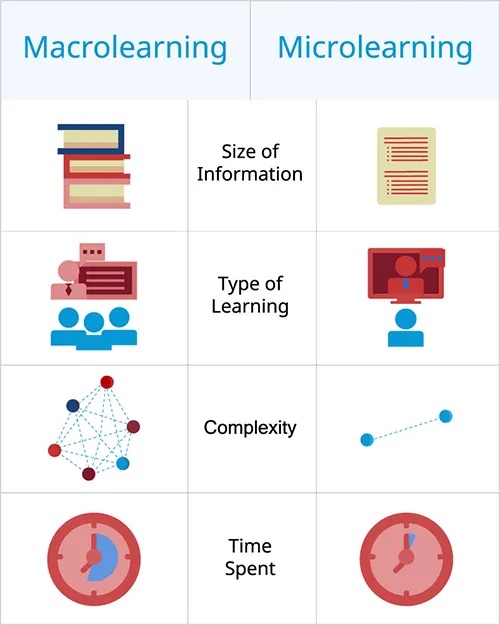How to Deliver Engaging, Bite-Sized Content for Effective Employee Development
Introduction
The corporate learning landscape is rapidly evolving, and one trend that has gained significant traction in recent years is microlearning. I work at an Ed-Tech company called Get More Brain, I’ve witnessed first-hand the growing importance of incorporating effective learning strategies into organizations worldwide. In this blog, we’ll explore microlearning, its benefits, and how it’s revolutionizing employee development.
Understanding Microlearning and Its Benefits
Microlearning refers to the process of delivering learning content in small, focused segments, typically no longer than five minutes. These short bursts of information are designed to be easily digestible, engaging, and highly targeted, making them an ideal solution for today’s busy workforce.
Microlearning has many benefits. According to a study conducted by the Association for Talent Development, learners who engaged in microlearning experienced a 22% increase in knowledge retention compared to those who engaged in traditional, longer-form e-learning. Other advantages include:
- Flexibility: Microlearning allows learners to access content at their convenience, fitting learning into their busy schedules. For instance, a microlearning course could be accessed on a smartphone during a commute, allowing learners to make the most of otherwise wasted time.
- Higher engagement: The short, focused format keeps learners engaged and motivated. For instance, learners can complete a microlearning course in one sitting, reducing the chances of them losing interest or leaving the course incomplete.
- Continuous learning: Microlearning enables employees to continually update their skills and knowledge, promoting a growth mindset.

Best Practices for Implementing Microlearning
Successfully incorporating microlearning into your organization’s learning strategy requires thoughtfulness. Based on my experiences working with diverse workforces across the globe, here are some best practices:
- Identify the right content: Break down complex topics into smaller, focused segments that are easy to digest.
- Leverage multimedia: Utilize a variety of formats, such as videos, quizzes, and infographics, to keep the content engaging.
- Personalize the experience: Offer customized learning paths tailored to individual needs and goals.
Overcoming Common Microlearning Challenges
As with any learning strategy, microlearning has its challenges. Two common obstacles are content curation and learner motivation. In a previous blog, I discussed the potential of AI in putting “Learning” back into Learning and Development, which can be particularly relevant when applied to microlearning. By selecting relevant, high-quality content, you ensure learners receive the information they need. To maintain motivation, provide regular feedback, and track progress to celebrate achievements and identify areas for improvement.
Get More Brain’s Role in Microlearning
While discussing microlearning, it’s worth mentioning how Get More Brain supports this learning approach through its innovative platform. Although not explicitly a microlearning platform, Get More Brain offers features that facilitate engaging, bite-sized learning experiences. With AI-driven personalization, learners receive targeted, relevant content while focusing on what’s important to them, such as short quizzes and summaries.
In addition to AI-driven personalization, Get More Brain offers a range of interactive features like progress tracking, and collaborative learning spaces, empowering learners with engaging and effective bite-sized learning experiences.
Real-World Success Stories
Throughout my career, I’ve seen numerous success stories that showcase the power of microlearning. For instance, a multinational corporation implemented a microlearning strategy to improve its sales team’s product knowledge. As a result, the company experienced a significant increase in sales revenue, demonstrating the tangible impact of this approach on performance. In another example, a global technology firm used microlearning to streamline its onboarding process, reducing training time considerably while improving employee satisfaction. These examples illustrate the potential benefits of microlearning in various aspects of employee development.
The Future of Microlearning and Corporate Learning
Microlearning has already made a significant impact on the corporate learning landscape, and I believe its influence will only grow. As organizations look for efficient, engaging ways to upskill their workforce, microlearning will become an increasingly popular solution. The integration of emerging technologies, such as virtual reality and artificial intelligence, will further enhance the microlearning experience, making it even more immersive and personalized.
Conclusion
The microlearning revolution is here, and organizations that embrace this approach will reap the benefits of a more skilled, engaged, and productive workforce. As an advocate for corporate learning and development, I’ve seen the positive impact microlearning can have on employees and overall business performance. By understanding microlearning principles, overcoming common challenges, and leveraging platforms like Get More Brain, companies can create a dynamic, modern learning environment that supports their workforce’s growth and success.
As we continue to explore innovative learning strategies, feel free to revisit my previous blogs on Why Managers Must Adapt to Motivate Gen Z in the Workplace and Empowering Your Sales Team for Success: How Personalized and Interactive Training Can Make the Difference to further understand how technology is shaping the future of corporate learning. I’m always eager to connect with like-minded individuals and exchange insights on #tech, #learning, #learningplatform, #corporatelearning, and #learningandevelopment. Let’s continue the conversation and work together to create a brighter future for corporate learning.
If you’re interested in learning more about how Get More Brain can help your organization, I invite you to follow me on Medium or Linkedin, leave a comment below, or reach out to me directly. Let’s connect and explore how we can work together to drive performance, engagement and retention in your workplace.
This post was first published on Medium.


